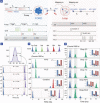A hybrid quantum memory-enabled network at room temperature
- PMID: 32083174
- PMCID: PMC7007260
- DOI: 10.1126/sciadv.aax1425
A hybrid quantum memory-enabled network at room temperature
Abstract
Quantum memory capable of storage and retrieval of flying photons on demand is crucial for developing quantum information technologies. However, the devices needed for long-distance links are different from those envisioned for local processing. We present the first hybrid quantum memory-enabled network by demonstrating the interconnection and simultaneous operation of two types of quantum memory: an atomic ensemble-based memory and an all-optical Loop memory. Interfacing the quantum memories at room temperature, we observe a well-preserved quantum correlation and a violation of Cauchy-Schwarz inequality. Furthermore, we demonstrate the creation and storage of a fully-operable heralded photon chain state that can achieve memory-built-in combining, swapping, splitting, tuning, and chopping single photons in a chain temporally. Such a quantum network allows atomic excitations to be generated, stored, and converted to broadband photons, which are then transferred to the next node, stored, and faithfully retrieved, all at high speed and in a programmable fashion.
Copyright © 2020 The Authors, some rights reserved; exclusive licensee American Association for the Advancement of Science. No claim to original U.S. Government Works. Distributed under a Creative Commons Attribution NonCommercial License 4.0 (CC BY-NC).
Figures




References
-
- O’Brien J. L., Furusawa A., Vučković J., Photonic quantum technologies. Nat. Photonics 3, 687–695 (2009).
-
- Jin X.-M., Ren J.-G., Yang B., Yi Z.-H., Zhou F., Xu X.-F., Wang S.-K., Yang D., Hu Y.-F., Jiang S., Yang T., Yin H., Chen K., Peng C.-Z., Pan J.-W., Experimental free-space quantum teleportation. Nat. Photonics 4, 376–381 (2010).
-
- Gisin N., Thew R., Quantum communication. Nat. Photonics 1, 165–171 (2007).
-
- Ladd T. D., Jelezko F., Laflamme R., Nakamura Y., Monroe C., OBrien J. L., Quantum computers. Nature 464, 45–53 (2010). - PubMed
-
- Aspuru-Guzik A., Walther P., Photonic quantum simulators. Nat. Phys. 8, 285–291 (2012).
LinkOut - more resources
Full Text Sources

